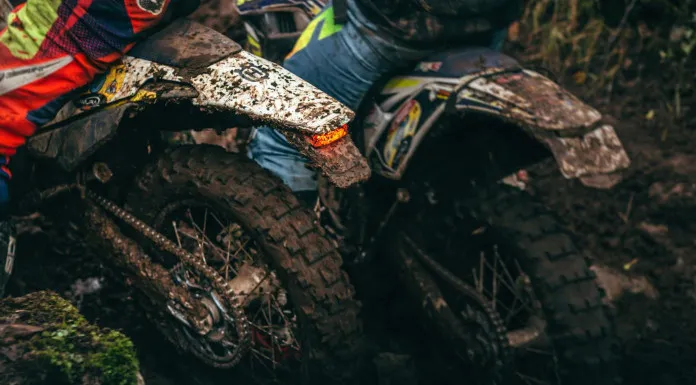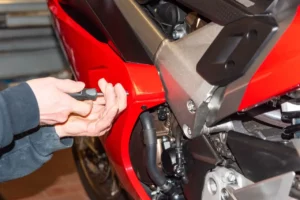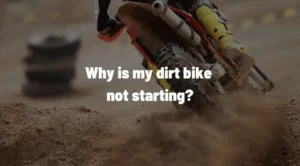Dirt bikes look worn when the plastic is dirty or scratched. In order to make the old bike look new again, the following 3 methods can be very useful for you. But it will need effort from you, and these steps will make your dirt bike shine.
By applying sandpaper, you can remove enough layers of plastic to display a new appearance layer underneath. To regain the shine of the plastic, buff it until the surface shines. You can apply an abrasive paste to protect the plastic for several months.
Let’s now discuss the cleaning method in detail:
How can you make your dirt bike plastic shine?
Step 1. Cleaning Bike Plastic
Mix detergent and water to make a cleaning solution.
Take a clean bucket and squeeze it with 1 tablespoon (15 ml) of dishwashing liquid.
Next, put cold or lukewarm water in the bucket and shake it by hand to dissolve the soap.
If necessary, buy a dirt bike cleaning product. These are used to clean and lubricate metal parts of dirt bikes. However, if you’re focusing on polishing plastic, you probably don’t need a particular product.
Soak the sponge in soapy water and rub it against the plastic. Soak a soft cloth in soapy water if you do not have a sponge.
Rub a soap sponge or fabric onto the plastic in a circular motion to remove any dirt.
Frequently soak the sponge in soapy water to avoid rubbing the bike with a dirty sponge.
Rinse the plastic with water to remove the soap.
Next, turn on the hose and spray clean water on the plastic to wash away all the soap.
If you do not have a hose, empty the bucket and rinse thoroughly. Then fill the bucket with water and pour it over a piece of plastic.
You can use a high-pressure washer on your dirt bike, but be careful. Avoid spraying on the chain, as the pressure can trap dirt and water inside the chain.
If the plastic is dirty, clean it again. Look at the surface of the plastic to see if all the dirt has been removed.
There are scratches, but you can remove them before polishing the plastic.
If it is dirty, rewash the plastic parts with soapy water and rinse them. Then wipe the plastic with a soft cloth before smoothing the scratches.
Step 2. Remove scratches with sandpaper
Take the universal blade and use it to scratch the top layer of old plastic. If the bike’s plastic is old and covered with scratches, pass a universal blade straightedge over it.
Continue scratching the plastic in one direction until it looks the same as the original colour. Always be careful when handling sharp blades. It may be easier to use the edge in the blade holder.
Rub a damp # 220 sandpaper over the plastic to smooth the surface scratches. Next, soak a sheet or block of 220 grit sandpaper in water and rub it against the plastic.
Work by moving the sandpaper back and forth, moistening it frequently. It helps to wear away the scratches.
Continue working with 220 sandpaper until the deepest scratches disappear a little.
If it is easy to hold, use sandpaper blocks instead of sandpaper.
320 Switch to grit sandpaper and rub against the plastic.
After smoothing the deepest scratches, switch to sandpaper No. 320 and soak in water.
Rub the sandpaper back and forth until the scratches disappear further. Process the entire surface of the plastic so that it is uniform.
Frequently soak the sandpaper in water to smooth the surface.
To buff the plastic, polish the plastic with moistened 400 grit sandpaper. Soak the fine sandpaper in water and spread the sandpaper evenly over the plastic.
The 400 grit sandpaper does not smooth the scratches but polishes the plastic to give the bike a shine.
If you have it, you can use finer sandpaper. For example, try polishing the plastic with 800 or 1000 grit sandpaper.
Wipe the plastic with a soft cloth to dry and remove any dirt. Take a soft cloth, such as microfiber, and wipe the cloth to dry the plastic and remove dirt from the sanding process.
A smooth and clean cloth is essential to avoid accidentally damaging freshly repaired plastic.
Step 3. Polishing Plastic
Attach a 10 cm polishing wheel to the electric drill. Buy a new buff and make sure it is free of compounds, degreasers, and stains from previous projects. Then, slide it onto the drill bit until it locks in place.
Using a high-power drill bit, rotate quickly to polish and shine plastic.
Switch on the drill and hold the wheel at an angle to the plastic. Tilt the polishing wheel so that only the edges touch the plastic.
Continue making a grip while rotating and rocking the wheel back and forth across the surface of the plastic. Be careful when wearing eye protectors and using a drill.
Do not hold the buff in one place for an extended period, as the plastic may heat up and melt.
Press the polishing pad against the surface of the plastic until it glows—buff wheels on all parts of the bike’s plastic. Stop occasionally and look for areas of soft plastic you may have missed.
Change to a smaller buff pad to buff curved or hard-to-reach areas.
To increase the brilliance, apply a polishing paste to the polishing disc. The bike is polished, but the plastic becomes dull over time, so you’ll have to repeat this every few months.
To extend the life of the shine, soak the buff pad in plastic polish and buff the polished plastic. The polishing paste can give the plastic a little extra shine and provide a protective layer.
How to Remove Rust from the Dirt Bike?
A rusty dirt bike can turn an exciting experience into a bumpy mess or spoil your dirt bike’s average shine.
Don’t take your dirt bike to an expert for rust elimination; in most cases, you may get rid of dirt bike rust yourself.
Depending on the severity of your dirt bike rust, you could use household items like baking soda and vinegar or cleanse chemical substances to get the process done. Once your dirt bike is rust-free, you’ll be ready to go again as soon as once.
Method 1. Using Baking Soda on Minor Rust
Mix baking soda and water in a bowl. Combine a 50/50 baking soda and water aggregate in a bowl and blend till it turns into a thick paste.
You will want the fine paste to cowl the rust, so keep the bowl, baking soda, and water close by if you make extra.
Baking soda is commonly excellent at minor rust removal. However, severe rusting can also additionally reply higher to different techniques.
Add a squirt of lemon juice to the paste for reinforced elimination properties.
Put the paste at once on the rust for approximately 15 min. Dab the paste on a broom or sponge and use it on the rusty dirt bike.
Do no longer scrub or get rid of the paste immediately: it will want time to set and spoil down the rust. Let the paste take a seat down for approximately 10 to fifteen mins.
The baking soda paste must be thick enough to calmly coat the rust patch without dripping off the dirt bike.
Scrub the baking soda with a scrub pad. Using a plastic scrubber or metallic wool, scrub the baking soda solution.
You must observe the rust breaking down and detaching from the dirt bike as you clean. If you no longer keep this, upload the baking soda paste to the dirt bike and scrub with extra force.
Use a toothbrush as an opportunity if no scrub pads are available.
Wait approximately 10 minutes before wiping off the baking soda. After scrubbing, go away the baking soda for about 10-15 mins to attain the desired rust. Then, wipe off the paste with a dry microfiber cloth. Make sure the dirt bike is dry to save you in addition to rust.
Store the dirt bike in a cool, dry area to prevent rust from returning.
If a little rust is left over, repeat the identical method or strive for another approach.
Expert’s Method: If your chain is rusty because your dirt bike has been outside, check it out and notice if the hyperlinks are tight and no longer moving.
If you don’t have stiff links, you may commonly oil the chain and wipe it down to get rid of floor rust.
However, a stiff hyperlink will purpose the chain to bypass because it is going via the drivetrain, so it’s probably worth getting a brand new chain.
Method 2. Using Vinegar on Stubborn Rust
Pour white vinegar into a twig bottle. White vinegar is excellent at rust elimination because it’s much more acidic than different varieties.
Although you may dab the vinegar onto the dirt bike rust all at once, spray bottles are perfect for ensuring an excellent liquid coating.
Add a small spoonful of baking soda to the aggregate for an extra corrosive answer.
Spritz or coat the rust on your dirt bike with vinegar. If you place the vinegar in a twig bottle, spray it calmly across the entire rust patch.
Apply the vinegar with a sponge or ball of tinfoil if deciding to coat it at once. Tinfoil is particularly powerful because it may additionally feature as a scrub brush even as you observe the vinegar.
If desired, you could soak detachable dirt bike components in a vinegar answer as an opportunity.
Rinse the vinegar off your dirt bike after 10-15 mins. Vinegar can maintain corroding your dirt bike metallic after doing away with the rust. To save this from happening, use a hose to scrub the dirt bike down after the rust has dissolved.
If vinegar no longer gets rid of the rust, you could want to apply a chemical cleaner.
Dry the dirt bike off earlier than storing it once more. Leaving moisture on the dirt bike can cause rust to return.
Rub your dirt bike with a material soaked in denatured alcohol to eliminate extra water. Then, store your dirt bike in a cool, dry area to prevent rust.
Method 3. Trying a Chemical Rust Remover
Use chemical rust remover if no other approach works. In a few cases, family gadgets won’t be sturdy enough to get rid of rust.
Try baking soda and vinegar first; however, if neither work, buy a rust remover from your neighbourhood hardware or dirt bike shop.
Do not blend chemical removers with baking soda, vinegar, citric acid, or different cleaners. Some combos may be deadly.
Put on defensive gloves and glasses before dealing with rust remover. Chemical removers are stronger to apply than different techniques and might damage your eyes or skin.
If the cleanser touches your eyes or skin, rinse it off very well and get in touch with poison management for additional instructions.
Avoid the use of chemical cleaners in limited spaces.
Brush the chemical cleanser on as directed. How long you go away, the cleaner will rely upon the chemical. Suggested instances can vary from half-hour to overnight. Please read the guidelines for unique commands and comply with them cautiously for excellent results.
If you want a cleanser to get rid of rust quickly, examine the label commands even as you’re at the shop and pick out one with a short putting time.
Remove the cleanser after the advised time has passed. Because chemical cleaners are corrosive, wipe it away absolutely with a reasonably-priced material after it has completed doing away with the rust. Store closing cleaners.
Conclusion
Finally, we have concluded this article, and let’s wind it up, but before you do, you should know what you have read here. You would have got to know how to make your dirt bike plastic shine. Follow these steps, and your dirt bike plastic will become new.






